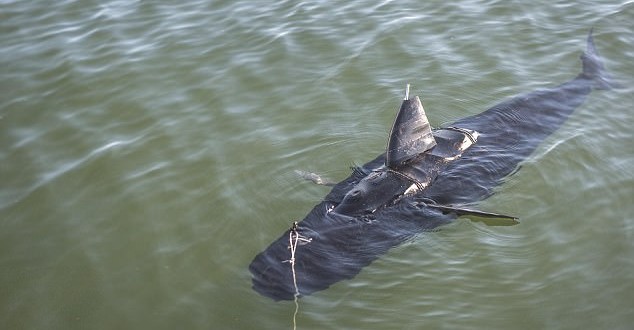US Navy Creates Robot Tuna? The United States Office of Naval Research has been working on a covert robot, capable of infiltrating enemy territory. Dubbed “Project Silent Nemo,” the robot is five feet long, weighs a hundred pounds and looks like a bluefin tuna. It is the Navy’s first spy tuna.
The Navy hopes it could be used to inspect the hulls of ships, check for underwater threats such as mines, and undertake secret reconnaissance missions.
Researchers from the Chief of Naval Operations Rapid Innovation Cell (CRIC) and Boston Engineering tested the prototype at the Joint Expeditionary Base Little Creek in Virginia.
Over the past several weeks, Boston Engineering’s device, also known as GhostSwimmer, has been gathering data on tides, varied currents, wakes, and weather conditions for the development of future tasks.
The unmanned vehicle was developed to resemble the shape and mimic the swimming style of a large fish.
Measuring approximately 5ft and weighing nearly 100lb, the drone can operate in water depths ranging from 10in to 300ft.
Michael Rufo, director of Boston Engineering’s Advanced Systems Group, said: “GhostSwimmer will allow the Navy to have success during more types of missions while keeping divers and sailors safe.”
He added: “It swims just like a fish does by oscillating its tail fin back and forth.
“The unit is a combination of unmanned systems engineering and unique propulsion and control capabilities.”
The robot is capable of operating on its own for extended periods of time due to its long-lasting battery, but it can also be controlled via laptop with a 500ft tether.
The tether is long enough to transmit information while inspecting a ship’s hull, for example, but if operating on its own the drone will have to periodically be brought to the surface to download its data.
“This project and others that we are working on at the CRIC are important because we are harnessing the brainpower and talents of junior sailors,” said Captain Jim Loper, department head for Concepts and Innovation, Navy Warfare Development Command (NWDC).
“Our mantra is ‘you have permission to be creative’. We want our people to go out there and dream big dreams and put them into action.
“We want to see projects like this replicated throughout the fleet.”
Agencies/Canadajournal

 Canada Journal – News of the World Articles and videos to bring you the biggest Canadian news stories from across the country every day
Canada Journal – News of the World Articles and videos to bring you the biggest Canadian news stories from across the country every day


“Sorry Charlie”